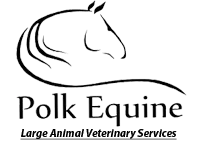During any stage of a horse's life, it's possible for him or her to develop lameness. Usually, lameness occurs from strain, injury, or stress. It's vital to seek out the care of a skilled veterinarian like Dr. Katie Hennessy for a lameness examination if you notice any signs of your horse having difficulty walking.
Gathering Information About Your Horse's Medical History and Lifestyle
Information about your horse's medical history and lifestyle can help our vet accurately diagnose the cause of the lameness. The staff at Polk Equine will ask you questions specifically related to lameness, such as when it first began.
We'll acquire information about your horse's age and breed. Horses are more likely to develop certain issues as they age while some breeds are more prone to certain problems. During this part of the lameness examination, Dr. Hennessy will ask about your horse's training regimen and any information about riding. We'll also ask you for information about when your horse was last shoed.
About the Physical Examination
The second part of your horse's lameness examination consists of a physical examination. Dr. Hennessy will assess your stallion or mare at rest to check his or her balance and ability to bear weight. Dr. Hennessy will look for any obvious signs of an injury or stress at this point as well. The physical exam may also include watching your horse walk. By analyzing your horse in motion, our practitioner can look for signs of a problem, such as gait deviations, short strides, unusual weight shifting, stiffness, etc.
Dr. Hennessy will also perform a hands-on exam by checking your horse's tendons, muscles, bones, and joints for any evidence of swelling, pain, or other abnormalities. A joint flexion test consists of our veterinarian holding your horse's limb and bending it. When your horse moves afterward, our vet evaluates his movement for irregularities and signs of pain.
At the appointment, our practitioner may use a hoof tester, which is a device that applies pressure to the bottom of your horse's feet. It evaluates the soles for sensitivity and pain.
Imaging and Further Diagnostics
Sometimes, the physical examination and medical history portion of the appointment is enough to diagnose the problem. However, it's possible our vet will want to conduct further testing.
Nerve and joint blocks are one possible diagnostic. Dr. Hennessy performs this procedure by temporarily stopping sensation to different areas until your horse's lameness subsides. Ultimately, this helps Dr. Hennessy determine where the problem is as well as if it's treatable.
At Polk Equine we may use radiography to identify the location of any damage or changes within the tissue. Dr. Hennessy can look at ligaments, tendons, and structures with the horse's joint. Other options include sonography, arthroscopy, and fluid samples, among others.
Treating Lameness
Once we diagnose the cause of the lameness, Dr. Hennessy will decide on the appropriate course of action. Sometimes, it's prescribing medication to help manage the pain along with encouraging you to make sure your horse receives adequate rest while he or she heals. Some other treatments may include a bandage, wound dressing, or antibiotics.
Lameness can be painful for your horse. Dr. Hennessy realizes the seriousness of lameness and will diagnose and treat the problem. To learn more about or schedule an equine lameness exam, contact Polk Equine today at 863-287-8413.


